Unit 6 : Sources of Energy in the World
Key unit Competence
Evaluate the energy sources in the world
My goals
By the end of this unit, I will be able:
* identify sources of energy in Rwanda.
* outline the basic features of renewable and non renewable energy
sources.
* evaluate energy uses and availability in Rwanda.
* identify various advantages and disadvantages of various energy
sources.* be aware of the moral and ethical uses associated with use of energy.
Introductory activity
At hospital, during patient treatment, doctors recommend to patients to take
a balanced diet. That is true because as a patient takes medicines and eatvery well, it yields a quick recovery and one gets strong.
Questions:
1.What do you think is contained in food that we eat?
2.Discuss why it is very important to take a sunbath when a person is sick?3.Discuss other different sources of energy in environment?
Introduction
Origins of the power used for transportation, for heat and light in dwelling
and working areas, and for the manufacture of goods of all kinds, among other
applications. The development of science and civilization is closely linked
to the availability of energy in useful forms. Modern society consumes vast
amounts of energy in all forms: light, heat, electrical, mechanical, chemical,
and nuclear. The rate at which energy is produced or consumed is called power,
although this term is sometimes used in common speech synonymously with
energy.
Activity 1
Answer these questions.
a) What do you think when you hear the word “energy”? Give
its definition and that of the term “energy source”.
b) Among scientists and energy professionals, a standard list
of current energy sources would include: biomass (plant
matter), nuclear, coal, oil, geothermal, solar, hydro (rivers),
wave or tidal, natural gas, wind. Add other sources of
energy which you may know.
c) From the list given in (b) what is the major category of
renewable energy?
d) d) Between renewable and non-renewable energy which
one produces a little or no pollution or hazardous waste and
pose few risks to public safety? How the other produces it?
e) e) Discuss in groups this consequence above.
f) f) List as many as you can uses of renewable energysources.
Read carefully these key terms in the table below then give answers to relatedquestions.
Key Terms
Biomass energy Energy released from plants (wood, corn, etc)
through combustion or other chemical process
Fossil fuel A non-renewable energy resource that began to
form millions of years ago from the remains of
once living plants and animals. Its current formsinclude petroleum, coal and natural gas.
Geothermal energy Heat energy from the earth.
Hydropower Transformation of the energy stored in a depth ofwater into electricity.
Non renewable energy
Resources, such as fossil fuels that cannot bereplaced by natural processes at the same rate it is consumed.
Photovoltaic A chemical process that releases electrons from a
semi-conductor material in the presence of sunlightto generate electricity.
Renewable energy Resources, such as wind and water that can be
recycled or replaced at a rate faster than they areconsumed.
Solar Energy Energy from the sun; often captured directly
as heat or as electricity through a photovoltaicprocess.
Uranium An element that releases heat as it undergoes
radioactive decay.Wind energy Energy transferred with the motion of air in the
lower atmosphere that arises from differential
heating of the earth. The energy in the wind can be
extracted as mechanical energy to do work such as
grind grains (a wind mill) or generate electricity(wind turbine).
Wave energy Wave power captures the energy of ocean surface
waves, and tidal power. Converting the energy
of tides, are two forms of hydropower with
future potential; however, they are not yet widelyemployed commercially.
Worldwide, wood is the largest source of biomass for non-food energy, but
other sources are also used, including municipal wastes and crop wastes.
Crops such as sugar cane are used to make alcohol for transportation fuel.
In many developing countries, wood is the most important energy source.
Global resources of geothermal energy (the heat contained below Earth’s
surface) are so immense that they are usually considered to be renewable.
But this classification is not strictly correct, since the heat stored in any given
volume of rock or underground water is depletable. In addition, the most
easily accessed geothermal resources, natural hot springs and geysers, will
not last for more than a few decades if exploited for energy on a large scale.
Estimates vary widely as to how long fossil fuels, oil, coal, and natural gas
will last. These estimates depend on assumptions about how much fossil fuel
remains in the ground, how fast it will be used, and how much money and
effort will be spent to recover it. However, most estimates agree that, if present
rates of consumption continue, proven oil and natural gas reserves will run
out in this century, while coal reserves will last more than 200 years. Oncethey are used, these energy sources cannot be replaced.
Fossil fuel
Fossil fuels are fuels formed by natural processes such as anaerobic
decomposition of buried dead organisms. The age of the organisms and their
resulting fossil fuels is typically millions of years, and sometimes exceeds
650 million years. Fossil fuels contain high percentages of carbon and includecoal, petroleum and natural gas.
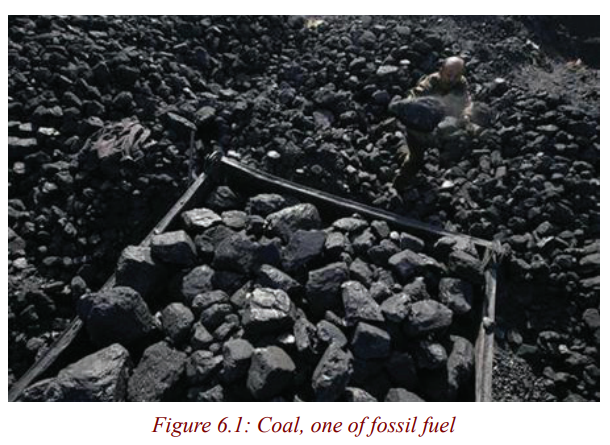
Rwanda’s main fossil fuel resource is methane gas. It is estimated that there
are 50 billion cubic metres of exploitable methane, which is the equivalent
of 40 million tons of petrol (TOE) laying at the bottom of the Lake Kivu
under 250 metres of water. Of the 55 billion cubic metres (cum) Standard
Temperature and Pressure, STP) of methane gas reserves, 39 billion cum
(STP) are potentially extractable. This represents a market value of USD 16
billion, equivalent to 31 million Ton Oil Equivalent (TOE). The technical and
economic feasibility of methane gas exploitation has been clearly demonstrated
since 1963 by the small methane extraction pilot unit at Cape Rubona with a
capacity of 5000 cum of methane per day at 80 % purity. The resource is
estimated to be sufficient to generate 700 mW of electricity for 55 years withRwanda’s share being 350 mW.

Nuclear fuel
Nuclear fuel is a material that can be ‘burned’ by nuclear fission or fusion toderive nuclear energy.
Most nuclear fuels contain heavy fissile elements that are capable of nuclear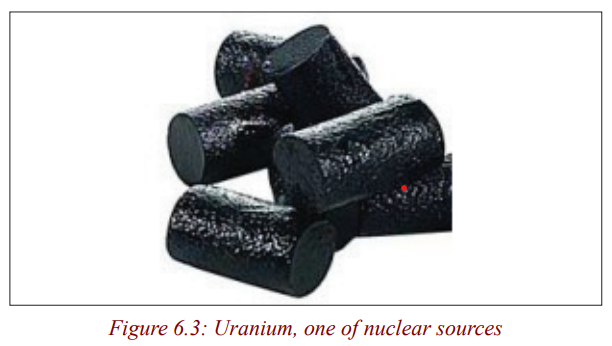
fission. When these fuels are struck by neutrons, they are in turn capable of
emitting neutrons when they break apart. This makes possible a self-sustaining
chain reaction that releases energy with a controlled rate in a nuclear reactor orwith a very rapid uncontrolled rate in a nuclear weapon.
“…Rwanda should choose a path to renewable energy—although nuclear is
the best other alternative; Rwanda does not have the technology to generatenuclear energy.
Even if Rwanda was ready to develop it despite the international laws and
regulations, nuclear energy poses a great danger especially, Rwanda being
located in a volcanic region. Nuclear energy for Rwanda in my opinion is a nogo option”. New times May 21, 2015
Renewable sources
Renewable energy is generally defined as energy that comes from resourcesthat
are not significantly depleted by their use, such as sunlight, wind, rain,
tides, waves and geothermal heat. Renewable energy is gradually replacing
conventional fuels in four distinct areas: electricity generation, hot water/space heating, motor fuels, and rural (off-grid) energy services.
Generally, Rwanda is well endowed with renewable energy resources, but most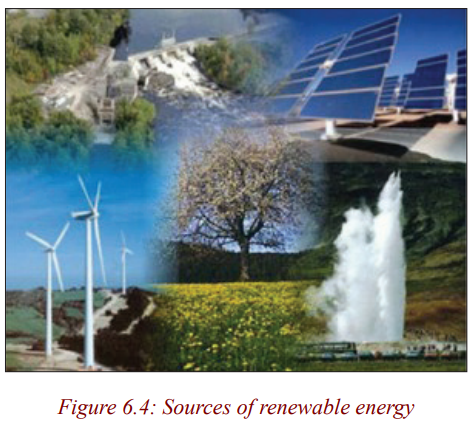
potential still remains untapped. Micro hydro-power in particular constitutes
a significant potential for rural power supply with many areas having ample
rainfall and most streams and rivers unexploited. Solar irradiation is high -
between 4-6 kWh/m2/day - but diffusion is hampered by high initial cost and
limitations on high load usage. Biogas is promising for thermal energy needs
for farms and small institutions, especially considering the large number ofhouseholds that own cows and other livestock.
Geothermal
Geothermal energy is from thermal energy generated and stored in the Earth.Thermal energy is the energy that determines the temperature of matter.
According to a study by Geothermal Energy Association, geothermal potential
in Rwanda ranges from 170 - 340 MW. In Rwanda geothermal is a main
energy policy priority and forms a significant part of the 7-year electricity
development strategy including a very ambitious action plan targeting 150
MW of generation capacity by 2017 (which represents up to 50% of total
generation). A Geothermal Act and a geothermal exploration and development
paper have been drafted although a proposal for a feed-in-tariff for geothermal
still needs to be developed. Three sites (Rubavu, Karongi and Rusizi) were
identified already in the 1980’s with resource temperatures in excess of 150°C
which could be suitable for geothermal power generation. In early 2012, test
drilling commenced to explore possibilities to harness energy in Rubavu,
Karisimbi, Kinigi located in western region as well as Bugarama in southern
region. The Government has self-financed and contracted the first exploratorydrilling in 2013.
Biomass and biofuels
Biomass is biological material derived from living, or recently living
organisms. It most often refers to plants or plant-derived materials which
are specifically called lignocellulosic biomass. As an energy source, biomass
can either be used directly via combustion to produce heat, or indirectly after
converting it to various forms of biofuel. Conversion of biomass to biofuel can
be achieved by different methods which are broadly classified into: thermal,chemical, and biochemical methods.
In Rwanda, It has been observed that if an average household used 1.8 tonnes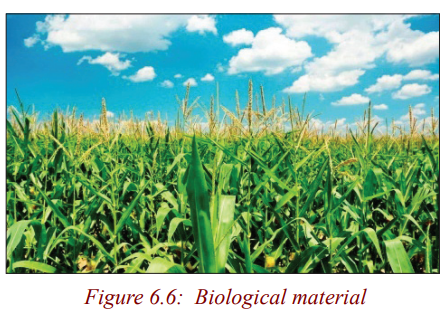
of firewood in a year to satisfy its cooking needs with a traditional stove, the
same household would use 3.5 tonnes of wood if it were to switch to charcoal
with an improved stove. The use of charcoal in urban areas, in combination
with high urban growth rates, therefore is a worrisome phenomenon that
accelerates pressure on wood resources. Peat is also a resource the government
intends to promote use of. It is estimated that there exists in Rwanda estimated
reserves of 155 million tons of dry peat spread over an area of about 50,000
hectares. About 77% of peat reserves are near Akanyaru and Nyabarongo
rivers and the Rwabusoro plains Potential for Peat-to-Power Generation. Peat
in the Rwabusoro marshland and around the Akanyaru river can fuel 450 mW
of electricity generation for 25 years. Currently, a cement plant and someprisons utilize peat for cooking
Biogas has been introduced in the country many years ago and Rwanda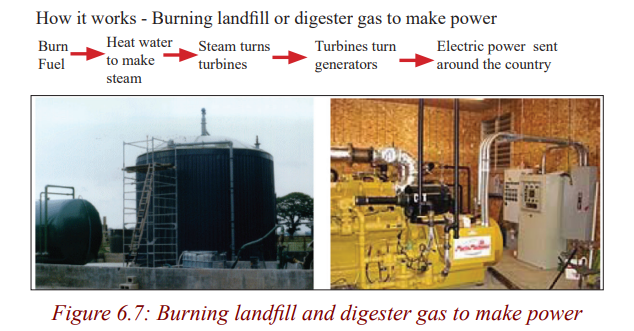
has gained international recognition for its program in prisons and large
institutions. The Government in 2008 announced a policy to introduce biogas
digesters in all boarding schools (estimated at around 600 schools), large
health centres and institutions with canteens to reduce the consumption of
firewood. This process started in 2010 but until today the focus has been
mainly on installations for schools. In total, about 50 large biogas digesters
have been constructed in institutions in Rwanda and the biogas systems that
have been installed in the prisons over the last decade have reduced firewoodconsumption by up to 40% and improved hygienic conditions.
Activities in the domestic biogas sector started much later. It is estimated that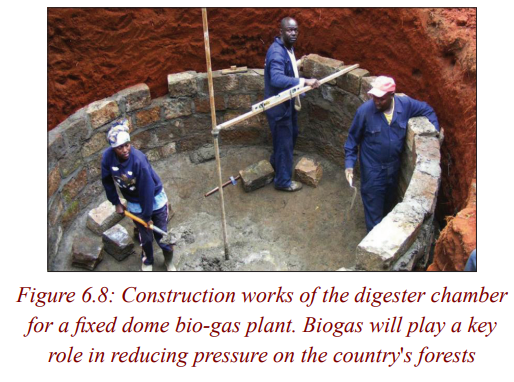
over 120,000 households have dairy cows that are kept under zero grazing
conditions to reduce soil erosion and also due to lack of grazing areas. These
numbers are increasing due to the governments programs to increase thenumber of families with dairy cows.
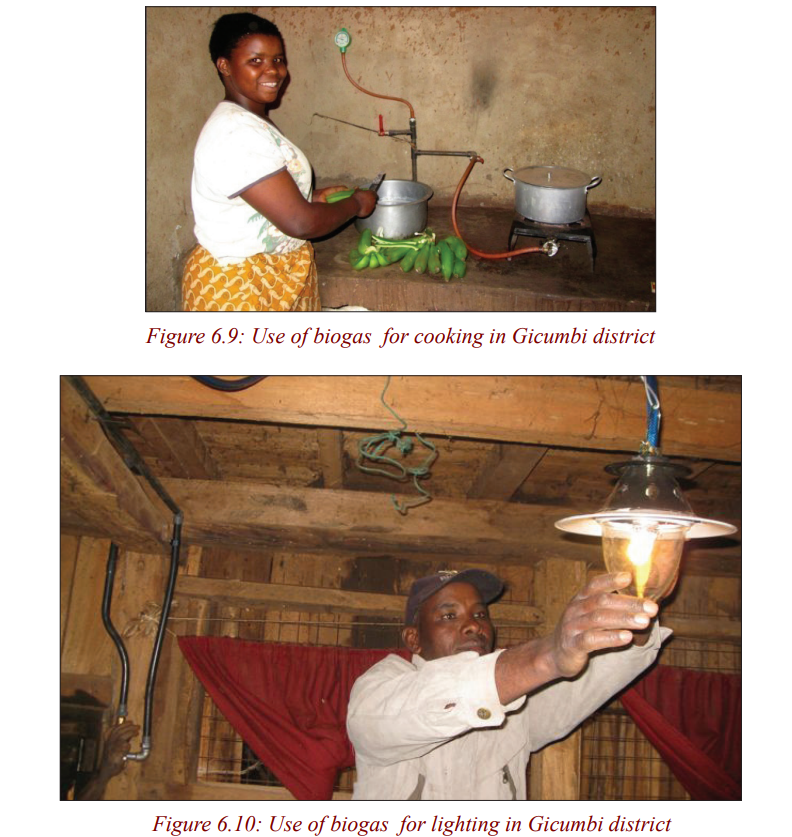
Solar energy (photovoltaic cells and solar heating panels)
Photovoltaic Cells
Solar energy, radiant light and heat from the sun, is harnessed using a range of
ever-evolving technologies such as solar heating, photovoltaic, concentratedsolar power, solar architecture and artificial photosynthesis.
The Rwandan government is set to commission the first utility-scale solar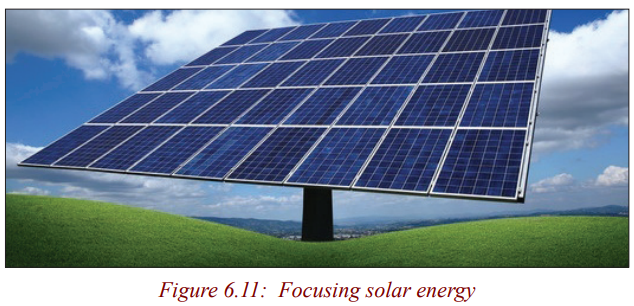
photovoltaic (PV) plant at eastern Rwanda’s Rwamagana district in August
2014 The project, with a production capacity of 8.5 mW, has commenced
testing, stated local reports. Dutch company Gigawatt Global is the developer
of the project, while Norwegian firm Scatec Solar has agreed to operate andmaintain the plant.

Solar Heating Panels
A solar thermal collector collects heat by absorbing sunlight. A collector is
a device for capturing solar radiation. Solar radiation is energy in the form
of electromagnetic radiation from the infrared (long) to the ultraviolet (short)wavelengths.
The term “solar collector” commonly refers to solar hot water panels, but may
refer to installations such as solar parabolic troughs and solar towers; or basicinstallations such as solar air heaters.
Hydroelectric power, wind power and wave power
Hydroelectricity
Energy in water can be harnessed and used. Since water is about 800 times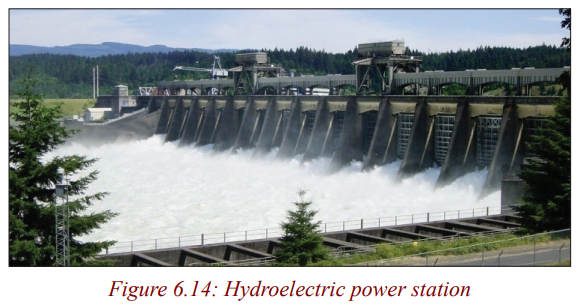
denser than air, even a slow flowing stream of water, or moderate sea swell,
can yield considerable amounts of energy. Hydroelectricity is the term
referring to electricity generated by hydropower; the production of electrical
power through the use of the kinetic energy of falling or flowing water. It is
the most widely used form of renewable energy, accounting for 16% of globalelectricity consumption.
The country currently has about 57 MW installed hydropower generating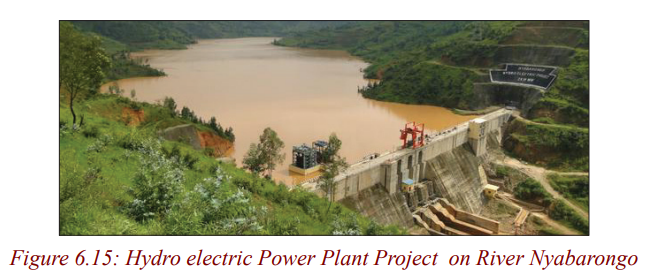
capacity. Hydroelectric power is mainly from the northern and southern parts
of the country (Musanze , Rubavu and Rusizi) namely from the following
power plants: Ntaruka, Mukungwa , Rubavu, Gihira as well as Rusizi 1 and
Rusizi 2. A number of new sources are supposed to come on line within
the coming years adding a capacity of 232 MW by 2013. This includes the
hydropower site Nyaborongo with 27.5 MW in Muhanga and Ngororero
Districts planned to come on line by February 2013 but currently experiencing
delays, and numerous mini/micro hydro plants adding up to 35 MW. The
new hydropower plant, Rukarara located in Nyamagabe district, Southern
Province, with 9.5 MW and costs of US$ 23.5 million was commissioned inJanuary 2011. Construction for this plant had already started in 2007.
Wind Power
Airflows can be used to run wind turbines. Modern utility-scale wind turbines
range from around 600 kW to 5 MW of rated power, although turbines with
rated output of 1.5–3 MW have become the most common for commercial
use; the power available from the wind is a function of the cube of the wind
speed, so as wind speed increases, power output increases up to the maximumoutput for the particular turbine.
Wind Potential in Rwanda has not been fully exploited for power generation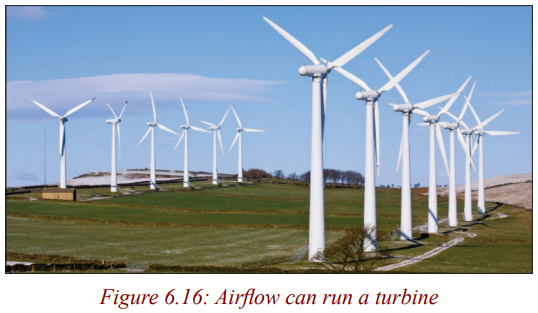
although potential wind power that Rwanda has in some areas may provide
with possible solutions such as water pumping, windmill and electricity
generation. A study of wind speed distribution has been made. (In this study,
the results have been found for the average wind speeds and directions for 3stations (Kigali, Rubavu and Huye) from 1985 to 1993.
These results can be summarised as follows:
• Direction of wind varies from 11 to 16°.
• Wind speed varies from 2 to 5.5m/s
The analysis of the wind energy possible solution for energy supply in rural
areas of Rwanda, was undertaken to estimate the wind power potential. In
total data from 4 stations (Kamembe, Huye, Nyagatare and Rubavu) have
been analysed by the National Meteorological Division in 1989. Once again,
the data from 3 synoptic sites (Kigali, Huye and Rubavu) are analysed by the
Weibull function. The considered data has been used to evaluate the annual
frequency of wind speed and the direction of wind, yearly variation of the
monthly average, annual and daily variation, and vertical profile of wind
energy potential. Nevertheless more detailed data is still required. In 2010 a
wind system was put in place to serve the Rwanda office of information RBA
on Mount Jali overlooking Kigali. This is the same site for the 250KW solar
system feeding to the grid. There is need for more thorough assessment of thewind potential in the country.
Wave Power
Wave power captures the energy of ocean surface waves, and tidal power,
converting the energy of tides, are the two forms of hydropower with futurepotential; however, they are not yet widely employed commercially.
Activity 2
Energy Source research
Purpose
Although most of the energy consumed in Rwanda comes from fossil fuel
sources, there are many other potential sources of energy available. In all
cases, there are pros and cons (advantages and disadvantages) to our use of
these sources. Some of the energy sources are limited by their availability
or environmental impact; others need technological improvements before
they can become widely used. For scientists and engineers, research is thebest way to learn about unknown topics.
In this section, we will examine information about energy sources and
how those sources are used to produce electrical energy. We can use this
information to help us understand the various pros and cons that affect
our use of different energy sources. In this activity, each group of students
will begin to become an expert on one aspect of each source of energy andreport their findings back to the class.
Procedure
1. Break into a group of 2-3 learners.
2. Choose or accept an assignment to research one particular question
about each source of energy.
3. Using the provided information packet, find the answer to your
question for all seven energy sources.
4. Once you have answered your question for all seven sources, answer
the two conclusion questions.As a class, we will fill in the energy sources chart based on your findings.
Research Questions
1. What is this energy source? Where can we find it in Rwanda?
2. How do we harness the energy? (How does it work?)
3. Are there different types or uses of this source? If yes, what are
the differences?
4. How is this energy source currently used? For example: At farms,
in industry etc. Could this source be used in a family home?
Note: Prepare a report summarizing your research and present the reportto the class.
Primary energy sources take many forms, including nuclear energy, fossil
energy-like oil, coal and natural gas - and renewable sources
like wind, solar, geothermal and hydropower. These primary sources are
converted to electricity, a secondary energy source, which flows through
power lines and other transmission infrastructure to your home and business.Activity 3
Discussion Questions
1. If you had to choose an energy system to tell your community about
based only on the aspect you researched, which system would you
choose? Why?
2. Why do we as a nation depend so much on fossil fuels? AND what doyou think we could do to reduce this dependence on fossil fuels?
Note: Prepare a report summarizing your research and present the reportto the class.
While listening to the other groups in your class present their information, list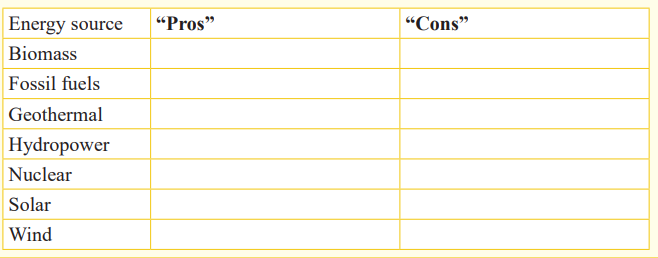
some “pros” and “cons” (advantages and disadvantages) of using their energy
source to solve your problem. While listening to the students in your group
present their information, list some “pros” and “cons” of using that energysource to solve the energy problem.
Advantages and disadvantages of renewable and non-renewable energies
Activity 6
Do research in the library or internet and complete the task below
1. Complete the chart below about the basic types of renewable energyresources.
2. List those energy sources that are fossil fuels.
_____________________________________________________
__________________________________________________________________________________________________________
3. What main advantage do fossil fuels have over the renewable
energy resources?
_____________________________________________________
__________________________________________________________________________________________________________
4. What are two main disadvantages of fossil fuels compared to
renewable energy?
_____________________________________________________
__________________________________________________________________________________________________________
The sun, prime source of world energy
Solar energy comes from thermonuclear fusion; 30% of solar energy arriving
on higher layers of atmosphere are reflected in space. 47% of that energy are
absorbed by the ground and oceans during daytime and become the Earth’s
internal energy. The remaining 23% of solar energy are used in evaporation
of water of oceans. When it rains, a part of energy is transformed into
potential gravitational energy, stocked in mountains, lakes, which are the
sources of hydroelectric power. About 0.2% is used by convection currents
in atmosphere and creates wind energy. Finally 0.02% is absorbed by plantsduring photosynthesis and is stocked by them in form of chemical energy.
Plants are sources of biomass. Photovoltaic cells transform solar energy inelectrical energy.
The table below show the summary of energy sources
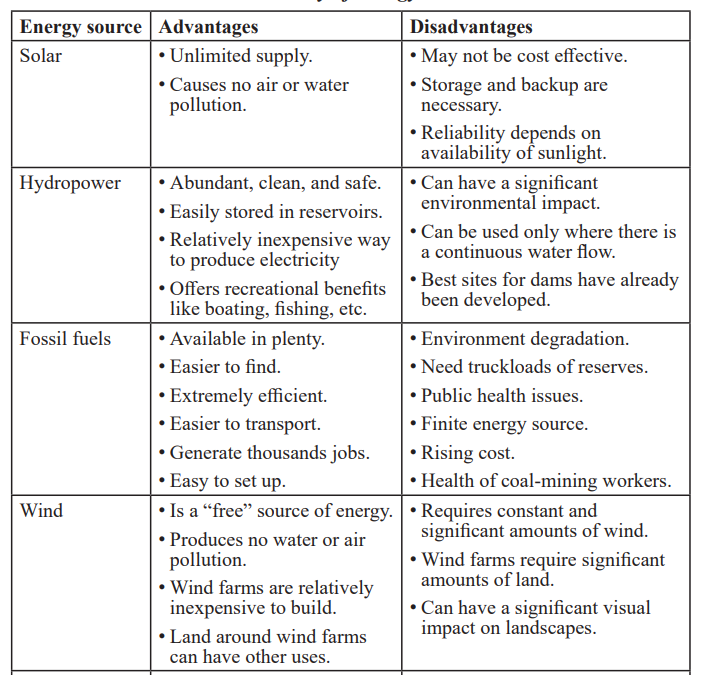
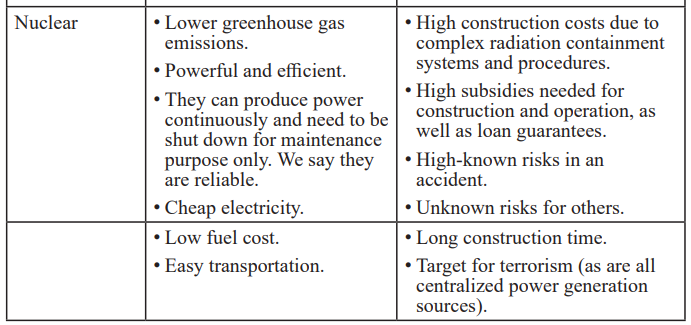

Extraction and creation of renewable and non-renewable energy sources
Activity 5
Creation of renewable and non renewable energy
From what you have already learned, you’ll do also research and tell
how these energies are created: Solar energy, hydropower, wind energy,
geothermal energy, and biomass. Try to find or to formulate how they areextracted.
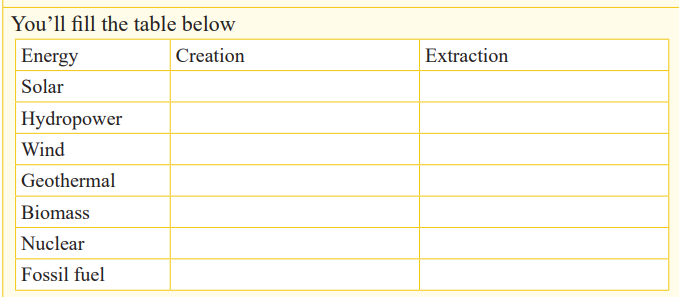
Creation
Non-renewable resources
A non-renewable resource (also called a finite resource) is a resource that
does not renew itself at a sufficient rate for sustainable economic extraction
in meaningful human time-frames. An example is carbon-based, organically-
derived fuel. The original organic material, with the aid of heat and pressure,becomes a fuel such as oil or gas.
Earth minerals and metal ores, fossil fuels(such as coal, petroleum, and natural
gas), nuclear fuels, and groundwater in certain aquifers are all non-renewableresources.
Natural resources such as coal, petroleum (crude oil) and natural gas take
thousands of years to form naturally and cannot be replaced as fast as they are
being consumed. Eventually it is considered that fossil-based resources will
become too costly to harvest and humanity will need to shift its reliance toother sources of energy. These resources are yet to be named.
Renewable resources
Natural resources, known as renewable resources, are replaced by natural
processes and forces persistent in the natural environment. There
are intermittent and reoccurring renewable and recyclable materials, which are
utilized during a cycle across a certain amount of time, and can be harnessedfor any number of cycles.
The production of goods and services by manufacturing products in
economic systems creates many types of waste during production and after
the consumer has made use of it. The material is then incinerated, buried in
a landfill or recycled for reuse. Recycling turns materials of value that wouldotherwise become waste into valuable resources again.
The natural environment, with soil, water, forests, plants and animals are
all renewable resources, as long as they are adequately monitored, protected
and conserved. Sustainable agriculture is the cultivation of plant and animal
materials in a manner that preserves plant and animal ecosystems over the
long term. The overfishing of the oceans is one example of where an industry
practice or method can threaten an ecosystem, endanger species and possibly
even determine whether or not a fishery is sustainable for use by humans.
An unregulated industry practice or method can lead to complete resourcedepletion.
Extraction
Resource extraction involves any activity that withdraws resources from
nature. This can range in scale from the traditional use of preindustrial societies,
to global industry. Extractive industries are, along with agriculture, the basis
of the primary sector of the economy. Extraction produces raw material
which is then processed to add value. Examples of extractive industries are
hunting, trapping, mining, oil and gas drilling, and forestry. Natural resources
can add substantial amounts to a country’s wealth, however a sudden inflow
of money caused by a resource boom can create social problems including
inflation harming other industries (“Dutch disease”) and corruption, leadingto inequality and underdevelopment, this is known as the “resource curse”.
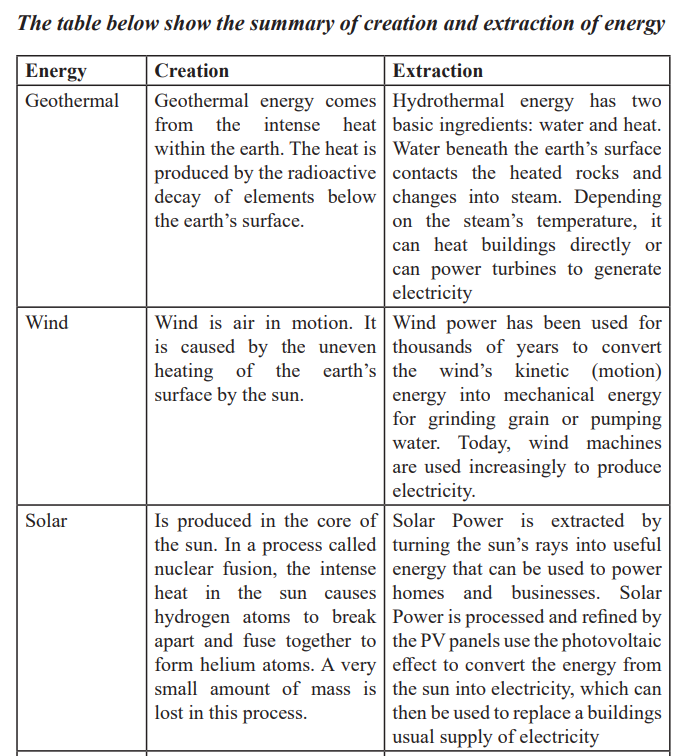

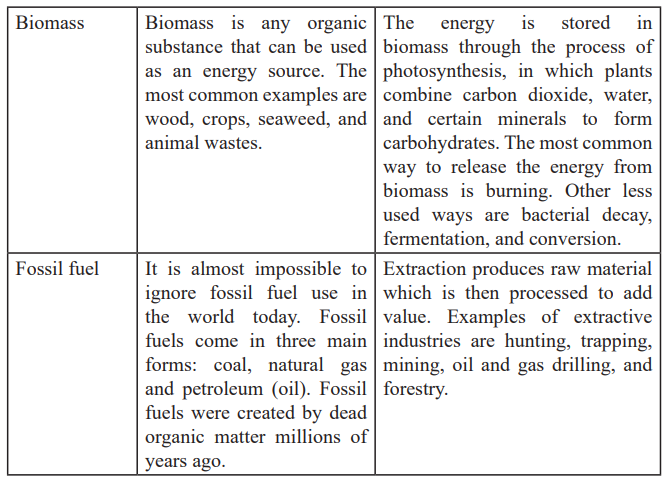
END UNIT ASSESSMENT
1. Differentiate between renewable and non-renewable energy
resources?
2. Using a table to distinguish renewable and nonrenewable resources:
Sun, coal, water, natural gas, wood; petroleum; wind; nuclear
fission; biomass
3. Which instrument is used to measure a wind energy?
4. What kind of energy will people be using in the future? Why?
5. What are benefits of renewable energy?
6. Why don’t people use more renewable energy now?
7. Are there reasons to use more renewables now rather than wait until
the non-renewables run out?
